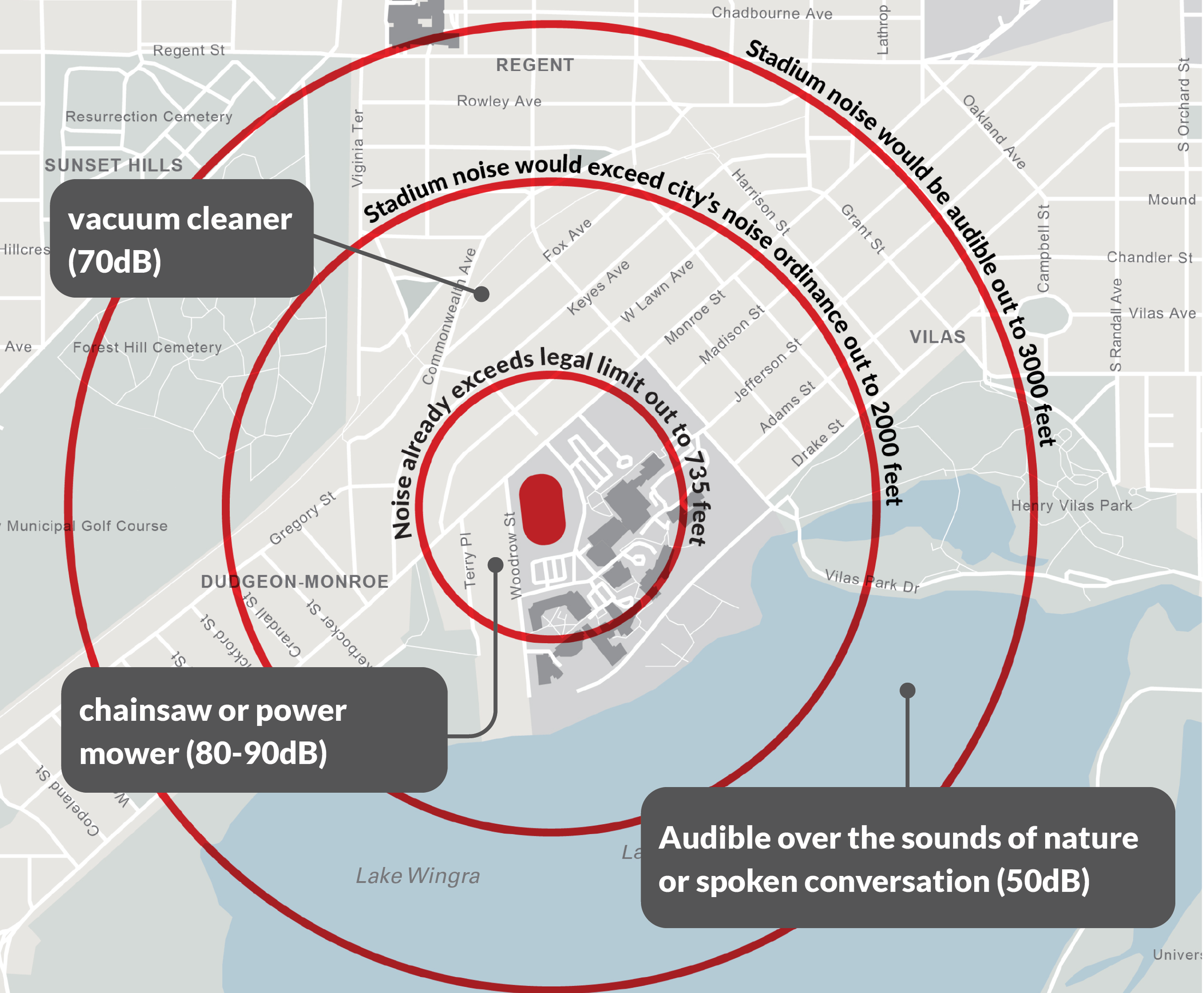Lights=noise
Noise levels exceeding 70dB will affect large areas of the Dudgeon-Monroe, Vilas and Greenbush communities. If Edgewood’s lighting permit is approved, we can plan on noise into the night as well as during the day.
What will it sound like? Levels will vary throughout an event but we can expect to experience audio comparable to:
a chainsaw or power mower (80-90dB) for those living within the smallest circle
a vacuum cleaner (70dB) for those living within the middle circle.
an electrical transformer (50dB) for those living 3000 feet away
Noise levels will interfere with conversation even if your windows are closed.
The World Health Organization (WHO) guideline value for nighttime noise in a sustainable urban setting is 40dB!
Sky glow from the field lights would impact everywhere on this map.
Let the kids play? Edgewood is legally permitted to play day games and that should be enough.
This is what a stadium sounds like
On Friday, October 5, 2018, engineer Ethan Brodsky collected quantitative data using professional light and sound meters at Waunakee High School football stadium. This is the site Edgewood has repeatedly used an example of what we can expect. Brodsky overlaid a map of the neighborhood, with the current location of Edgewood's practice field, onto a map of Waunakee's stadium, so he could observe the event from points that correspond to known points in the neighborhood. For each point, he matched the horizontal distance from the sideline and position along the field to a corresponding point on the neighborhood street.
Waunakee football stadium viewed as if you were looking at the proposed Edgewood Stadium from 830 Woodrow Street. Measure sound levels (A-weighted, fast response) were up to 73dB from the PA system and 82 dB from the band. Measured illuminence was 0.5 lux horizontal and 1.2 lux vertical.
This is Google Earth image with a 3000ft radius around the field.
Even in a quiet parking lot that is 3,000 feet from the field, with no direct line-of-sight path to the field, one could still hear the crowd noise, music, and PA. If you draw a circle that distance out from Edgewood's proposed stadium, it would include the area extending almost to Regent Street; Monroe Street from Wingra School to the public library, the Vilas Neighborhood out past Grant Street, much of Lake Wingra, and portions of the arboretum.
This is how it would sound on Monroe, Keyes, West Lawn, leonard…
Recorded in a parking lot roughly 750 feet from the sideline this video represents the way the stadium will sound to the many homes on the 2200 and 2300 blocks of Monroe and West Lawn, portions of Keyes and Leonard Street, and of course, Terry and Woodrow Streets. Even at this point, measured sound levels were 67 dB from the PA system and 64 dB from the band, far higher than the 60 dB
Noise pollution is a growing Threat
From the potential F-35s in Madison to enacting legal guidelines to protect wildlife in Washington state, noise pollution is a growing threat to humans and wildlife. No New stadium opposes F-35s in Madison. We support protecting our east and north side neighborhoods from the damaging impact of F-35s operating in the airspace above homes, schools and businesses.
NO LIGHTS. NO AMPLIFIED SOUND.
NO NEW STADIUM.
Is noise pollution the next big public health crisis. by David Owen, New Yorker. Research shows that loud sound can have a significant impact on human health, as well as doing devastating damage to ecosystems.
Noise pollution hurts wildlife, but states have trouble turning down the volume, by Alex Brown, Phys.org. Increasingly, research shows that human-caused noise can be harmful to many species.

